The Power of Yamaha

Yamaha's status as the Number 4 sled maker belies its world ranking in motor sports
With three of the four snowmobile companies based in North America, it’s a bit easy to be lazy and somewhat dismiss the elephant in the room, Yamaha. After all, despite taking over snowmobile market share dominance for a period after Arctic Cat fell into never-never land, Yamaha has since slid downward to fourth place in an industry that announced improved annual worldwide sled sales of 129,087 this past season. Based on the Japan-based company’s performance, we tend to look admiringly at Polaris for its 417-pound powder sled and nearly 50 percent market share in the West.
Yes, Polaris is a player with revenues approaching $3 billion annually. The snowmobile pioneer aggressively markets well-engineered snowmobiles. The company has both on- and off-road divisions, with an increased profile in green electric vehicle manufacturing. There is the in-house development of an electric side-by-side Ranger and the neighborhood Breeze EV, plus a fleet of GEM (Global Electric Motors) vehicles, an electric French mini-truck and there’s the buy-in of Brammo electric motorcycles. That’s all in addition to its gas-and-oil standbys, Polaris snowmobiles, ATVs, side-by-sides and Victory motorcycles. With the acquisition of the Indian motorcycle brand, Polaris should increase market share.
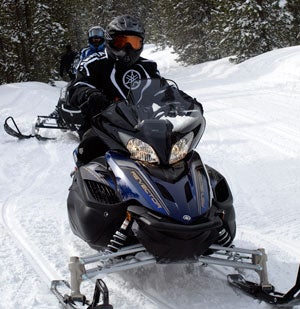 Yamaha redefined four-stroke efficiency in snowmobiling and brought innovative technologies that include electric power steering used on the 2013 Vector and Apex models.
Yamaha redefined four-stroke efficiency in snowmobiling and brought innovative technologies that include electric power steering used on the 2013 Vector and Apex models.When it comes to snowmobiling, most of us look at every other sled maker before we look at Yamaha. Let’s face it, the big Yamaha news for 2013 centers around a revamped Nytro with a new off-trail track package, a couple of two-up utility type sleds that were marketed in Canada already and a cute mini-sled in Yamaha blue. Fortunately for Yamaha, the competition isn’t coming into 2013 with totally innovative products. Polaris drops weight. Ski-Doo creates tMotion for the powder riders. Arctic Cat expands its popular “Pro” chassis line. But, unfortunately for Yamaha, the competition has done something. And when it comes to snowmobiling and snowmobilers, it’s a case of what have you doing for me now. Our sport is an unforgiving one. It’s one whose most avid enthusiasts buy what’s hot, exciting and new. They tend to forget that Yamaha re-imagined the world of four-stroke snowmobiling by bringing in a race-inspired four-cylinder, 150-horsepower sled, the RX-1. As the 2013 Apex, it’s hotter than ever with EXUP, electric power steering and a styling re-do just last season. Much of that went unnoticed, partially because the new look appeared too much like the old one! If only Yamaha had been bolder. The perception of change could have been greater and more reflective of the changes under the fiberglass!
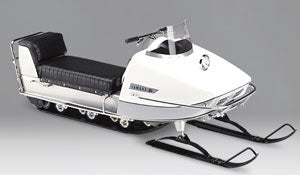 Introduced about 1968 as a test model with technology borrowed from more than a decade of motorcycle manufacturing, the SL350 represents the root of all Yamaha snowmobiles.
Introduced about 1968 as a test model with technology borrowed from more than a decade of motorcycle manufacturing, the SL350 represents the root of all Yamaha snowmobiles.So, here we are, transfixed, wondering what Yamaha is up to. Well, this is our opinion mind you; we think that Yamaha looks at the really big picture. Consider that the entire snowmobile industry retailed less than 130,000 snowmobiles last year. Consider that even if Yamaha sold all of those sleds, it would pale alongside the annual sales numbers Yamaha does in worldwide motorcycle sales. In India alone, Yamaha sold just under 45,000 motorbikes – in December of 2011. This is a company that worldwide retails millions of two-wheelers annually. Motorcycles make up 70 percent of the company’s annual net sales. By market, North America represents less than four percent of that.
If we look at the snowmobile side – which is buried in with Yamaha’s golf cars, ATVs and UTVs, generators, snow throwers and multi-purpose engines; Yamaha sees only eight percent of its net sales coming from this Power products group. But, of that, North America represents 52 percent. In other words, these power products account for about four percent of Yamaha’s $16 billion annual revenues. That would make Yamaha’s Power Products group on par with all of Arctic Cat.
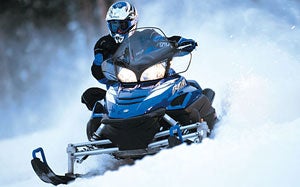 The RX-1 combined four-stroke motorcycle engine technology with an all-new chassis layout and was the industry’s first four-stroke, high-performance snowmobile.
The RX-1 combined four-stroke motorcycle engine technology with an all-new chassis layout and was the industry’s first four-stroke, high-performance snowmobile.According to the International Snowmobile Manufacturers Association (ISMA), the worldwide economic impact of snowmobiling is said to be about $34 billion annual. Yamaha as a standalone company has an economic impact of $16 billion.
As a Yamaha spokesman told us a couple of years ago, each division within the company stands on its own merit. What he meant was simply that the Yamaha snowmobile group, in general, has to budget its own research and development (R&D), marketing and such from a percentage of its own revenues. As for R&D, the sled group doesn’t ordinarily borrow development dollars from another group, although it is highly likely that when Yamaha developed the RX-1 four-stroke snowmobile, there was help from the motorcycle side. The four-cylinder four-stroke served as a base platform for Yamaha bikes, personal watercraft and a snowmobile. We suspect that there were shared resources in those projects. Plus, when all of this was going on, the sled side had the support of a key Yamaha executive who had once worked intimately with that group. It paid to have a friend in high places.
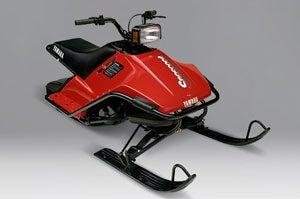 Offering an 80cc scooter engine and lightweight tube frame, the 1988 SnoScoot was built to attract new riders to the sport.
Offering an 80cc scooter engine and lightweight tube frame, the 1988 SnoScoot was built to attract new riders to the sport.When we look at the power of Yamaha, we come away impressed. As snowmobilers in North America we don’t see the brand name as we would in other parts of the world. We see only snowmobiles. But know that Yamaha has great brand recognition as the world’s Number 2 maker of motorcycles, a major player in outboard motors as well as various boats used for recreation as well as commercial fishing. More than nine percent of Yamaha sales comes from other products like unmanned helicopters used in agriculture, electrically powered wheelchairs and electric power assist bicycles.
When we see Yamaha, we look at the company through the eyes of a snowmobiler who only sees Yamaha as a company that offers sleds in the North American snow belt. We don’t recognize the global presence of Yamaha. This is a company focused on its future, which means needing to ramp up potential two-wheeler production to meet the needs of a global economy. That means Yamaha will expand to produce one million motorcycle units annually in Vietnam and another 3.6 million units in Indonesia. When we consider that snowmobiling represents 130,000 annual sales, maybe we can forgive Yamaha for being a bit distracted from time to time.
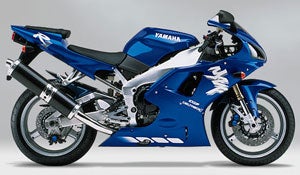 Yamaha’s 1998 R1 established new levels of power, handling and styling and offered its quad four-stroke engine as the basis for the RX-1 snowmobile.
Yamaha’s 1998 R1 established new levels of power, handling and styling and offered its quad four-stroke engine as the basis for the RX-1 snowmobile.Frankly, we are impressed that Yamaha continues to develop its snowmobile presence with new innovations like power steering, EXUP exhaust technologies and such. And, we fully expect that Yamaha will bring more enlightened product innovations to our future sleds. Think about what Yamaha’s strengths are in engine development and its unique casting methodologies in manufacturing sophisticated and lightweight diecast components. Since motorcycle technologies demand more and more fuel efficiency, expect Yamaha to jump on a direct injection technology that can be parsed to snowmobiles.
As we always do when thinking about the industrial power of Yamaha, we recall a tour of Yamaha’s Japanese snowmobile manufacturing facility that we were on a number of years ago. While we tried to keep up with our group, we fell back to view with awe a manufacturing line that was devoted to producing nothing but 50cc single cylinder scooter engines. We saw maybe three, no more than five, workers managing the machinery that output those millions of engines. We have visited other manufacturing facilities ranging from John Deere lawn and garden, Ski-Doo snowmobiles, Harley-Davidson engines and motorcycles to a Honda Gold Wing facility, but we have never witnessed the efficiency of anything like that Yamaha line – before or after.
As a snowmobiler we may get frustrated and impatient with Yamaha and how the company cautiously moves ahead in the sled business, but we’ll never underestimate this company’s capability when it zeroes on a target. Let’s hope that Yamaha brings a bit more global focus to snowmobiling in the near future. Of course, that may be just what Yamaha’s competitors fear.
Related Reading Snowmobile Sales Leaders Through the Years Snowmobile History: Big Money Players 2013 Yamaha Venture MP Review – Video 2013 Yamaha FX Nytro XTX 1.75 Review – Video








 Your Privacy Choices
Your Privacy Choices